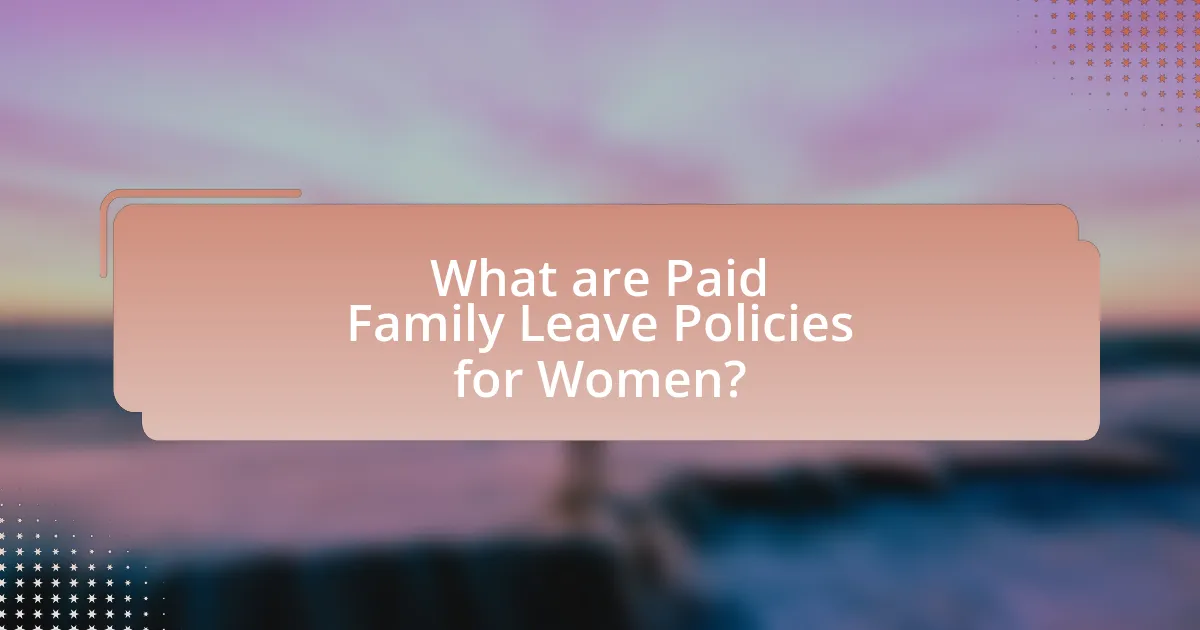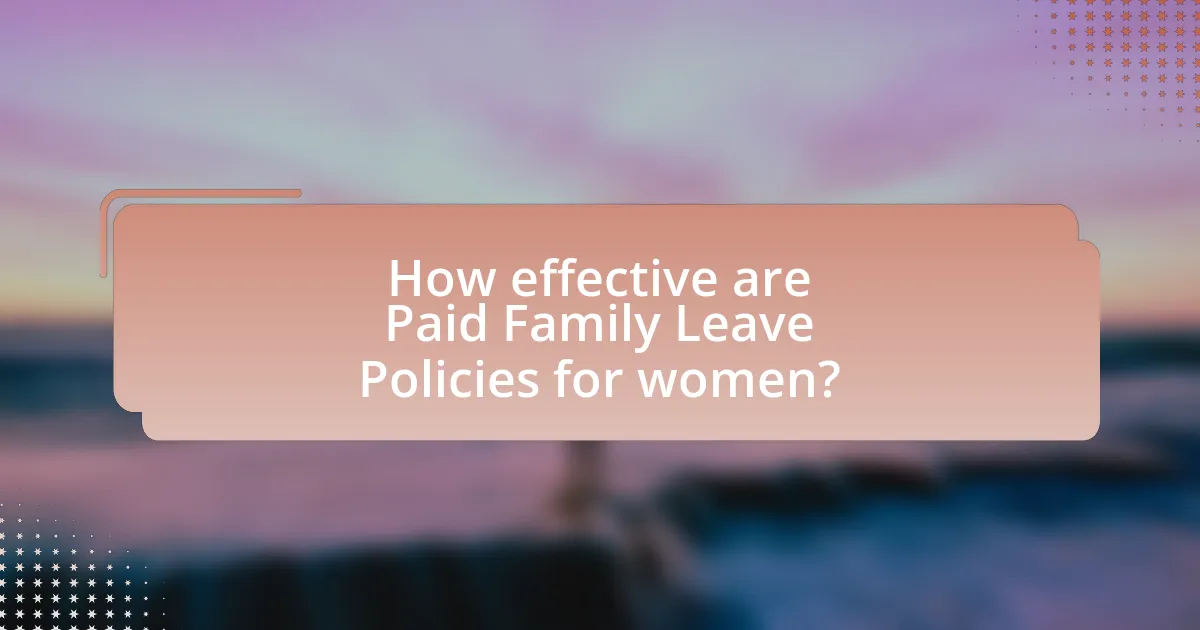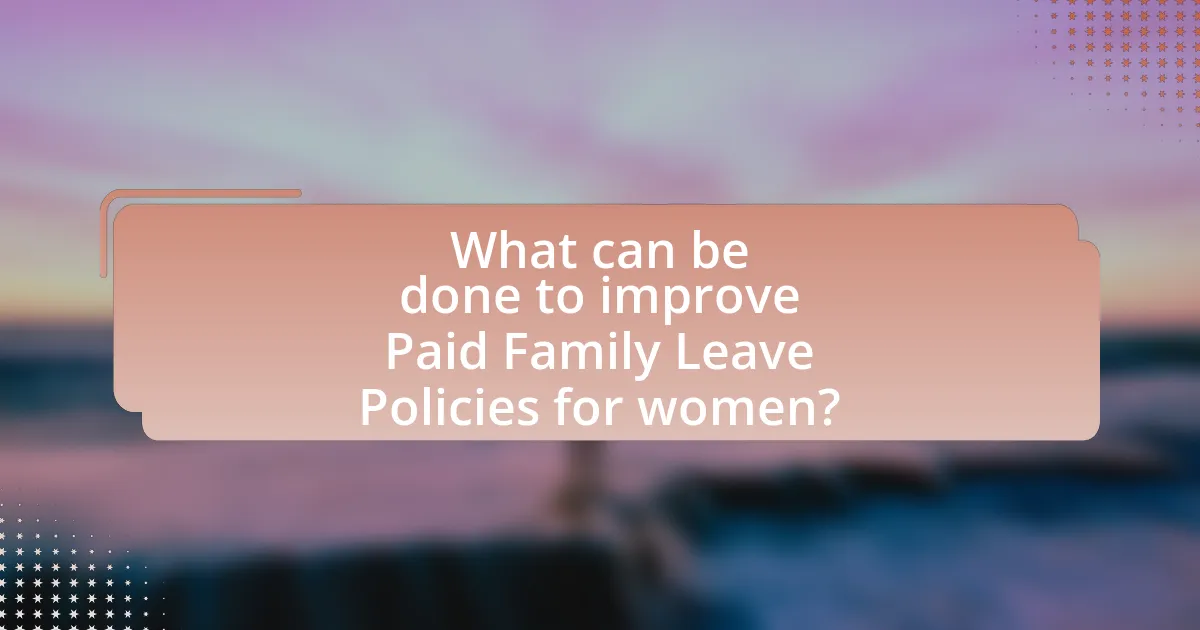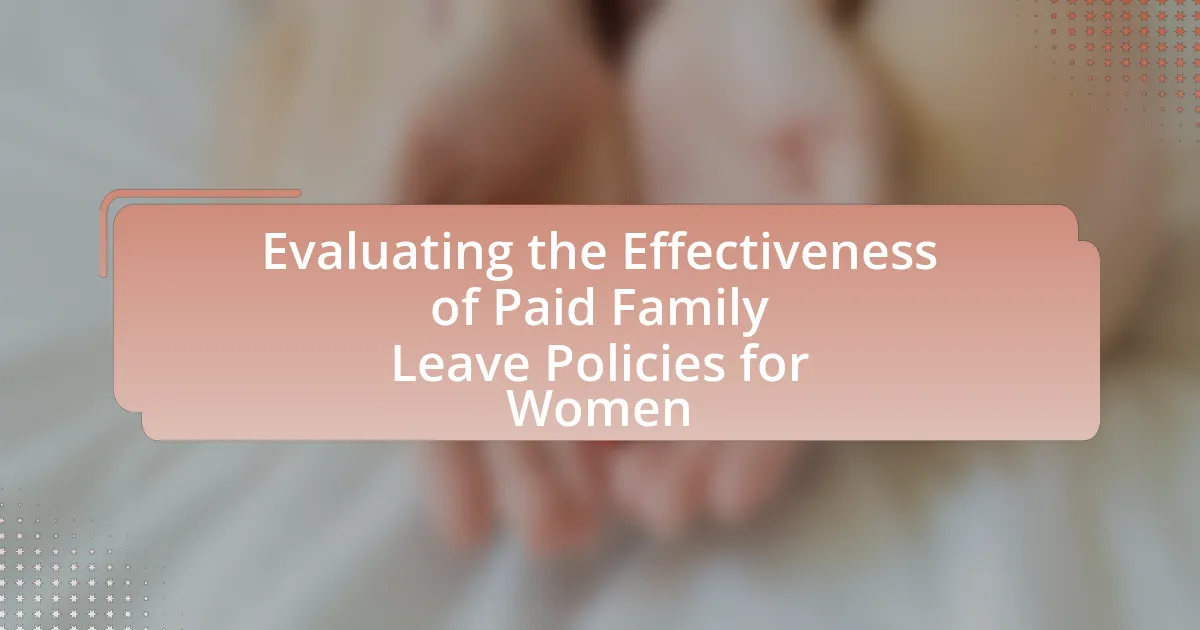Paid Family Leave Policies for Women are essential programs that provide paid time off for women to care for newborns, newly adopted children, or seriously ill family members, significantly impacting their health and economic stability. The article evaluates the effectiveness of these policies, highlighting variations across countries, key features, and the influence of cultural attitudes on their implementation. It discusses the importance of these policies for women’s workforce participation, health outcomes, and the challenges they face in accessing benefits. Additionally, the article examines the economic implications, criticisms, and recommendations for improving Paid Family Leave Policies to enhance inclusivity and effectiveness.

What are Paid Family Leave Policies for Women?
Paid Family Leave Policies for Women are government or employer-sponsored programs that provide paid time off for women to care for a newborn, newly adopted child, or a seriously ill family member. These policies aim to support women’s health and economic stability during critical family transitions. For instance, in the United States, the Family and Medical Leave Act (FMLA) allows eligible employees to take up to 12 weeks of unpaid leave, but some states have implemented paid family leave programs, such as California’s Paid Family Leave, which offers up to eight weeks of partial wage replacement. Research indicates that paid family leave can lead to improved maternal and child health outcomes, as well as increased workforce participation among women, demonstrating its effectiveness in promoting gender equity in the workplace.
How do Paid Family Leave Policies differ across countries?
Paid Family Leave Policies vary significantly across countries in terms of duration, compensation, and eligibility criteria. For instance, Sweden offers up to 480 days of paid leave at a high replacement rate, while the United States lacks a federal paid family leave policy, leaving it to individual states to implement their own, resulting in a patchwork of varying benefits. Countries like Germany provide 14 weeks of paid maternity leave with a high percentage of wage replacement, whereas in Japan, the leave can extend up to a year with a gradual increase in payment. These differences reflect varying cultural attitudes towards family support and gender equality, influencing women’s workforce participation and overall effectiveness of such policies.
What are the key features of Paid Family Leave Policies in various regions?
Paid Family Leave Policies across various regions typically include features such as duration of leave, wage replacement rates, eligibility criteria, and job protection. For instance, in California, the policy allows up to 8 weeks of paid leave with a wage replacement rate of approximately 60-70% of the employee’s salary, depending on income. In contrast, countries like Sweden offer up to 480 days of paid parental leave, with a high wage replacement rate of around 80% for the first 390 days. Additionally, many regions implement eligibility criteria based on employment duration or hours worked, ensuring that only those who have contributed to the system can access benefits. Job protection is also a common feature, safeguarding employees from termination during their leave period. These elements collectively aim to support families while promoting workforce participation, particularly among women.
How do cultural attitudes influence Paid Family Leave Policies?
Cultural attitudes significantly influence Paid Family Leave (PFL) policies by shaping societal expectations regarding gender roles and caregiving responsibilities. In societies where traditional gender roles prevail, there is often less support for PFL, as caregiving is viewed primarily as a woman’s responsibility, leading to policies that may not adequately support both parents. For instance, countries with progressive views on gender equality, such as Sweden, have implemented generous PFL policies that encourage shared parental leave, reflecting a cultural commitment to gender equity. Research indicates that in nations with strong cultural support for family leave, such as Norway, the uptake of PFL by fathers increased significantly, demonstrating how cultural attitudes can directly impact policy effectiveness and utilization.
Why are Paid Family Leave Policies important for women?
Paid Family Leave Policies are important for women because they provide essential support during critical life events such as childbirth and caregiving. These policies enable women to take time off work without losing income, which is crucial for their financial stability and mental health. Research indicates that access to paid family leave can significantly improve maternal health outcomes, with studies showing that women who take paid leave are less likely to experience postpartum depression. Additionally, paid leave policies promote gender equality in the workplace by allowing women to balance their professional and personal responsibilities, thereby reducing the stigma associated with taking time off for family needs.
What impact do these policies have on women’s workforce participation?
Paid family leave policies significantly increase women’s workforce participation. Research indicates that access to paid family leave allows women to maintain their employment during and after childbirth, reducing the likelihood of job loss or career interruptions. For instance, a study by the Institute for Women’s Policy Research found that states with paid family leave programs saw a 10-20% increase in women’s labor force participation rates compared to states without such policies. This demonstrates that paid family leave not only supports women’s roles as caregivers but also enhances their economic stability and career advancement opportunities.
How do Paid Family Leave Policies affect women’s health and well-being?
Paid Family Leave Policies significantly enhance women’s health and well-being by providing them with the necessary time to recover from childbirth and care for their newborns. Research indicates that access to paid leave is associated with lower rates of postpartum depression and improved maternal mental health, as women experience reduced stress and anxiety when they can take time off work without financial penalties. A study published in the American Journal of Public Health found that states with paid family leave saw a 10% decrease in maternal depression rates compared to those without such policies. Additionally, these policies promote better infant health outcomes, as mothers are more likely to engage in breastfeeding and attend pediatric appointments, which are crucial for both maternal and child health.
What challenges do women face in accessing Paid Family Leave?
Women face several challenges in accessing Paid Family Leave, including eligibility restrictions, lack of awareness, and financial barriers. Many policies require a minimum tenure at a job or a specific number of hours worked, which can exclude part-time or low-income workers. Additionally, studies indicate that a significant percentage of women are unaware of their rights regarding Paid Family Leave, leading to underutilization of available benefits. Financial constraints also play a role, as some women may not be able to afford to take unpaid leave or may fear job loss, which discourages them from applying for the leave. According to the National Partnership for Women & Families, nearly 40% of private-sector workers do not have access to any form of paid family leave, highlighting the systemic issues that hinder women’s access to these essential benefits.
What barriers exist in the implementation of Paid Family Leave Policies?
Barriers in the implementation of Paid Family Leave Policies include lack of funding, employer resistance, and insufficient awareness among employees. Funding challenges arise because many governments and businesses are hesitant to allocate financial resources for these policies, fearing increased costs. Employer resistance often stems from concerns about productivity loss and potential abuse of leave. Additionally, insufficient awareness among employees about their rights and the availability of these policies can lead to underutilization, undermining the intended benefits. These barriers collectively hinder the effective rollout and acceptance of Paid Family Leave Policies.
How do socioeconomic factors influence access to Paid Family Leave?
Socioeconomic factors significantly influence access to Paid Family Leave (PFL) by determining eligibility, awareness, and the ability to take leave without financial strain. Individuals from lower socioeconomic backgrounds often lack access to PFL due to employment in sectors that do not offer such benefits, as evidenced by a 2020 report from the National Partnership for Women & Families, which found that only 13% of low-wage workers had access to paid family leave compared to 60% of high-wage workers. Additionally, socioeconomic status affects knowledge about PFL policies; lower-income individuals may not receive adequate information or support to navigate these systems. Furthermore, financial constraints can deter individuals from taking leave, as they may fear losing income or job security, particularly in precarious employment situations.

How effective are Paid Family Leave Policies for women?
Paid Family Leave Policies are highly effective for women, significantly improving their labor force participation and economic stability. Research indicates that women who have access to paid family leave are more likely to return to their jobs after childbirth, with studies showing a 10-15% increase in retention rates. Additionally, these policies contribute to better maternal and child health outcomes, as women are able to take necessary time off without financial strain. For instance, a study by the National Bureau of Economic Research found that states with paid family leave saw a 5% increase in the likelihood of mothers returning to work within a year after giving birth.
What metrics are used to evaluate the effectiveness of Paid Family Leave Policies?
Metrics used to evaluate the effectiveness of Paid Family Leave Policies include employee retention rates, utilization rates of the leave, and impacts on maternal and child health outcomes. Employee retention rates measure how many employees return to work after taking leave, indicating the policy’s support for job security. Utilization rates reflect the percentage of eligible employees who take advantage of the leave, demonstrating accessibility and awareness of the policy. Additionally, studies show that effective Paid Family Leave Policies can lead to improved maternal health outcomes, such as reduced postpartum depression rates, and better child health outcomes, including increased vaccination rates and lower infant mortality rates. These metrics collectively provide a comprehensive assessment of the policy’s impact on families and the workforce.
How do we measure the economic impact of Paid Family Leave on families?
The economic impact of Paid Family Leave on families is measured through various metrics, including changes in household income, employment retention rates, and overall family well-being. Studies have shown that families utilizing Paid Family Leave experience a reduction in financial stress, with a 2019 report from the Institute for Women’s Policy Research indicating that access to Paid Family Leave can increase family income by an average of 20% during the leave period. Additionally, employment retention rates improve, as families are less likely to experience job loss during critical life events, which is supported by research from the National Bureau of Economic Research that found a 10% increase in job retention among parents who took Paid Family Leave. These metrics collectively provide a comprehensive view of the economic benefits that Paid Family Leave policies confer on families.
What role do surveys and studies play in assessing policy effectiveness?
Surveys and studies are essential tools for assessing policy effectiveness, as they provide empirical data on the impacts and outcomes of policies. In the context of evaluating paid family leave policies for women, surveys can capture the experiences and satisfaction levels of women utilizing these policies, while studies can analyze broader trends, such as workforce participation rates and economic impacts. For instance, research conducted by the National Bureau of Economic Research found that states with paid family leave policies saw a 10% increase in women’s labor force participation, demonstrating the tangible effects of such policies. This data-driven approach allows policymakers to make informed decisions and adjustments based on the evidence gathered from surveys and studies.
What evidence exists regarding the outcomes of Paid Family Leave Policies?
Evidence indicates that Paid Family Leave (PFL) policies lead to positive outcomes for women, including increased workforce participation and improved maternal health. Studies show that states with PFL, such as California and New Jersey, report higher rates of women returning to work after childbirth compared to states without such policies. For instance, research published in the Journal of Policy Analysis and Management found that California’s PFL program increased the likelihood of mothers returning to work by 10-15%. Additionally, a study by the National Bureau of Economic Research highlighted that PFL contributes to better health outcomes for mothers and infants, reducing the incidence of postpartum depression and improving child health metrics. These findings collectively demonstrate that PFL policies significantly benefit women in the workforce and enhance family health.
How do these policies influence child health and development?
Paid family leave policies significantly enhance child health and development by allowing parents to spend crucial early months with their newborns. This time fosters secure attachment, which is essential for emotional and cognitive development. Research indicates that children whose parents take paid leave experience lower rates of infant mortality and improved health outcomes, such as higher vaccination rates and better overall physical health. For instance, a study published in the Journal of Health Economics found that states with paid family leave saw a 10% reduction in infant mortality rates. Additionally, these policies support maternal mental health, reducing postpartum depression, which positively impacts child development.
What are the long-term effects of Paid Family Leave on women’s careers?
Paid Family Leave positively impacts women’s careers in the long term by enhancing job retention, increasing earnings, and promoting career advancement. Research indicates that women who utilize Paid Family Leave are less likely to experience job loss after childbirth, with studies showing a 50% reduction in turnover rates among those who take leave. Additionally, women who take Paid Family Leave often see a 10% increase in their earnings over time compared to those who do not, as they are more likely to return to their previous positions or advance in their careers. This correlation is supported by a study from the National Bureau of Economic Research, which found that access to Paid Family Leave leads to improved labor market outcomes for women, thereby reinforcing the importance of such policies in fostering gender equity in the workplace.
What are the criticisms of Paid Family Leave Policies?
Criticisms of Paid Family Leave Policies include concerns about their financial sustainability and potential negative impacts on businesses. Critics argue that funding these policies can strain public budgets and lead to increased taxes, which may disproportionately affect low-income workers. Additionally, some business owners contend that mandated paid leave can create operational challenges, particularly for small businesses that may struggle to cover employee absences without incurring significant costs. Research from the National Bureau of Economic Research indicates that while paid family leave can improve employee retention, it may also lead to increased hiring costs and reduced job opportunities for certain demographics, particularly younger workers.
What are the common arguments against Paid Family Leave Policies?
Common arguments against Paid Family Leave Policies include concerns about increased costs for employers, potential negative impacts on workforce dynamics, and fears of misuse of the benefits. Critics argue that implementing such policies may lead to higher payroll taxes or increased prices for consumers, as businesses may pass on the costs. Additionally, opponents suggest that these policies could create a stigma against hiring women or parents, as employers might perceive them as less committed to their jobs. Studies have indicated that in some cases, paid leave can lead to disruptions in workplace productivity and may encourage employees to take leave even when it is not necessary, further straining resources.
How do critics view the economic implications of these policies?
Critics view the economic implications of paid family leave policies as potentially burdensome for businesses and the economy. They argue that these policies may lead to increased costs for employers, which could result in reduced hiring, lower wages, or even layoffs. For instance, a study by the National Bureau of Economic Research found that while paid family leave can improve employee retention, it may also impose significant financial strain on small businesses that struggle to absorb the costs associated with providing paid leave. Critics emphasize that the economic impact varies widely depending on the structure and funding of the policies, suggesting that without careful design, the intended benefits could be overshadowed by negative economic consequences.

What can be done to improve Paid Family Leave Policies for women?
To improve Paid Family Leave Policies for women, policies should be expanded to provide longer leave durations and ensure full wage replacement during the leave period. Research indicates that countries with comprehensive paid leave policies, such as Sweden and Norway, have higher rates of maternal employment and better health outcomes for both mothers and children. Additionally, implementing universal access to paid family leave, regardless of employer size, can reduce disparities faced by women in lower-wage jobs. Evidence from the U.S. shows that states with more generous paid leave policies report increased workforce participation among women, highlighting the effectiveness of such measures in supporting women’s economic stability and family well-being.
What best practices can be adopted from successful Paid Family Leave models?
Successful Paid Family Leave models adopt several best practices that enhance their effectiveness. These practices include providing adequate duration of leave, typically 12 to 16 weeks, which research shows is essential for both maternal and child health outcomes. Additionally, offering a wage replacement rate of at least 66% helps ensure that families can afford to take the leave without financial strain, as evidenced by studies indicating that higher wage replacement correlates with increased leave uptake. Furthermore, inclusive policies that cover all workers, regardless of employment status, promote equity and accessibility, as demonstrated by models in countries like Sweden and Norway, where universal coverage has led to higher participation rates. Lastly, clear communication and support for employees regarding their rights and the application process significantly improve utilization rates, as highlighted by successful programs in California and New Jersey.
How can policymakers enhance accessibility and inclusivity in Paid Family Leave?
Policymakers can enhance accessibility and inclusivity in Paid Family Leave by implementing universal eligibility criteria that cover all workers, regardless of employment status or company size. This approach ensures that part-time, gig, and low-wage workers, who often lack access to such benefits, are included. For instance, the Family and Medical Leave Act (FMLA) in the United States currently excludes many workers; expanding eligibility could increase coverage significantly. Additionally, providing financial support to small businesses can facilitate their ability to offer Paid Family Leave, thereby promoting inclusivity. Research indicates that states with more inclusive Paid Family Leave policies, such as California, have seen increased participation rates among diverse populations, demonstrating the effectiveness of these measures.
What role do advocacy groups play in shaping Paid Family Leave Policies?
Advocacy groups play a crucial role in shaping Paid Family Leave policies by mobilizing public support, influencing legislation, and raising awareness about the needs of families. These organizations often conduct research and disseminate data that highlight the economic and social benefits of Paid Family Leave, which can sway policymakers. For instance, studies have shown that access to Paid Family Leave can improve maternal and child health outcomes, leading advocacy groups to push for policies that reflect these findings. Additionally, advocacy groups frequently collaborate with lawmakers to draft legislation, ensuring that the voices of affected families are included in policy discussions. Their efforts have been instrumental in the passage of Paid Family Leave laws in various states, demonstrating their significant impact on policy development.
What recommendations can be made for future Paid Family Leave Policies?
Future Paid Family Leave Policies should prioritize inclusivity, ensuring coverage for all workers regardless of employment status, and should provide adequate duration and wage replacement to support families effectively. Research indicates that policies offering at least 12 weeks of leave with 70% wage replacement significantly improve maternal and child health outcomes, as evidenced by studies from the National Bureau of Economic Research. Additionally, implementing flexible leave options can accommodate diverse family needs, enhancing overall participation and satisfaction.
How can data-driven approaches improve policy design and implementation?
Data-driven approaches can significantly enhance policy design and implementation by providing empirical evidence that informs decision-making. For instance, analyzing data on the utilization rates of paid family leave can reveal patterns in how different demographics access these benefits, allowing policymakers to tailor programs to meet specific needs. A study by the National Bureau of Economic Research found that states with paid family leave policies saw a 10% increase in labor force participation among new mothers, demonstrating the positive impact of data-informed policy adjustments. By leveraging such data, policymakers can create more effective, equitable, and responsive family leave policies that better serve women and families.
What strategies can be employed to raise awareness about Paid Family Leave?
To raise awareness about Paid Family Leave, targeted communication campaigns can be employed. These campaigns should utilize social media platforms, community events, and partnerships with local organizations to disseminate information effectively. For instance, a study by the National Partnership for Women & Families found that 70% of voters support Paid Family Leave when they are informed about its benefits, highlighting the importance of education in awareness efforts. Additionally, leveraging testimonials from individuals who have benefited from Paid Family Leave can create relatable narratives that resonate with the public, further enhancing awareness and understanding of the policy’s significance.
How can women effectively navigate Paid Family Leave Policies?
Women can effectively navigate Paid Family Leave Policies by thoroughly understanding their rights and the specific provisions of the policies available to them. Familiarizing themselves with the eligibility criteria, duration, and benefits of the leave can empower women to make informed decisions. For instance, the Family and Medical Leave Act (FMLA) in the United States allows eligible employees to take up to 12 weeks of unpaid leave for certain family and medical reasons, which can be crucial for planning. Additionally, women should communicate with their employers about the policies and seek clarification on any ambiguities. Research indicates that women who actively engage with their workplace policies are more likely to utilize their leave effectively, as highlighted in a study by the National Partnership for Women & Families, which found that informed employees are more likely to take advantage of available benefits.
What resources are available to help women understand their rights regarding Paid Family Leave?
Women can access various resources to understand their rights regarding Paid Family Leave, including government websites, legal aid organizations, and advocacy groups. The U.S. Department of Labor provides comprehensive information on the Family and Medical Leave Act (FMLA), detailing eligibility and benefits. Additionally, organizations like the National Partnership for Women & Families offer guides and resources tailored to women’s rights in the workplace, including Paid Family Leave. Legal aid organizations, such as the Legal Services Corporation, can assist women in understanding their rights and navigating the application process. These resources collectively empower women with the knowledge needed to advocate for their rights effectively.
What tips can women follow to maximize their benefits from Paid Family Leave Policies?
To maximize benefits from Paid Family Leave Policies, women should thoroughly understand their rights and the specific provisions of the policy in their state or employer. Familiarizing themselves with eligibility criteria, duration of leave, and compensation rates is essential, as these factors vary significantly across different jurisdictions. For instance, a study by the National Partnership for Women & Families indicates that states with comprehensive paid family leave laws provide better financial support and job protection, which can enhance women’s ability to take full advantage of these policies. Additionally, women should communicate their needs clearly with their employers, ensuring that they request leave in a timely manner and provide any necessary documentation to avoid complications. Engaging with support networks or advocacy groups can also provide valuable insights and resources, further empowering women to navigate the complexities of Paid Family Leave effectively.


